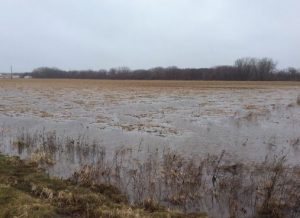It’s January 25th, do you know where your nitrogen is? What about your soil?
Given the changes we have seen in our weather patterns, these are appropriate questions for farmers at any time of the year. Even though this is not the time of year when we typically think about losing nitrogen and soil, we saw a 5+ inch rainfall event in central Iowa in mid-December and an even larger rainfall event in Missouri two days after Christmas with historic flooding at the beginning of the new year!
I did a quick internet search for extreme weather events over the last 4 years. I uncovered the following headlines in a short amount of time.
- Flooding kills off some Ohio corn crops, ponding could hurt performance later (June 29, 2015)
- Flooding affects western Kansas, Garden (June 28, 2014)
- Kansas: Wind Erosion – Emergency Measures to Control Blowing Soil (January 17, 2014)

Iowa – December, 2015
OK, you get the idea. I found similar headlines for Texas, north through the Dakotas, and east to the Atlantic; all for events within the last 4 years. Sure, we have always had extreme weather events. But, our events are becoming more frequent and more severe.
It is time to rethink soil conservation and crop nutrient management strategies. More resilient strategies need to be implemented to account for the more extreme weather events. Growers can build resilience by implementing the BMPs. These include applying fertilizer closer to the time of crop uptake, stabilizing the nitrogen, building soil health and improving water infiltration.
So, why aren’t these sustainable practices being adopted? I believe it is because farmers do not know how much nitrogen or soil they are losing. It is difficult to manage what you don’t measure.
Think of this being like the front door on your house. Have you replaced the door or added weather stripping lately? What if you could have your door tested and you find out you are losing $100/year because of energy inefficiency? Would you take action? Sure you would. Armed with information, you can at least make an educated decision. Like energy loss, soil loss and nitrogen loss can be invisible; out of sight, out of mind.
 Top 5 Scary Conservation Math Facts
Top 5 Scary Conservation Math Facts
You say: “Growers can build resilience by implementing the practices included in SUSTAIN. These include applying fertilizer closer to the time of crop uptake, stabilizing the nitrogen, building soil health and improving water infiltration.”
Those are fine things to do, but the Iowa Nutrient Reduction Strategy informs us that doing those things will not nearly get the job done. The fundamental problem is that unless there are cover crops on corn and soybean fields, there are no live roots in the ground to intercept and scavenge nitrate moving through the soil profile with percolating water during the time corn and soybeans are not growing. That nitrate is not just from fertilizer N–most of it can be from nitrate mineralized out of soil organic matter. Therefore, just improving fertilizer management will not suffice.
Francis, I absolutely agree. This is why I also mentioned “building soil health and improving water infiltration”. I just did not expound on these components. And yes, they are critical to achieving nutrient management goals.
To achieve soil health, we have to control erosion. After all, trying to measure soil health without controlling erosion is like trying to administer a health screening test to a person when they have a slashed artery.
Therefore, by making reference to soil health, I was implying that we need conservation practices, including cover crops. As you reiterated, practices like cover crops can intercept and scavenge nitrogen. They are also great at reducing erosion. Cover crops are definitely promoted in our Sustain platform.
The Sustain platform includes many other conservation practices such as ponds, wetlands, waterways, no-till, and strip-till, to name a few.
We all know there is no one silver bullet. The likelihood of everybody adopting one practice (such as cover crops) is about 0%. It will take a multitude of practices to achieve our goals. And, more efficient fertilizer management will help.
The point I was trying to make in the post was that it all starts with quantifying the loss (whether that is soil loss or nutrient loss). I am willing to guess that 90+% of the farmers/landowners have any idea how much they are losing. If we don’t quantify their losses, it is difficult to get change.
More efficient fertilizer management will help, but research shows that more efficient fertilizer management will only reduce nitrate going into Iowa’s rivers by 5 to 10%. Cover crops can reduce nitrate leaching by 30 to 55%.
Francis, I agree with you. I am not willing to stop with just one “miracle” practice though. There will be a segment of farmers who will not plant cover crops. Even if it is mandated, we cannot make cover crops grow in every situation in every year. Mother nature gets to decide that. There is no silver bullet. I do, and will continue to promote cover crops. I do, and will continue to promote improved fertilizer efficiency. And, I sure do, and will continue to promote soil conservation.